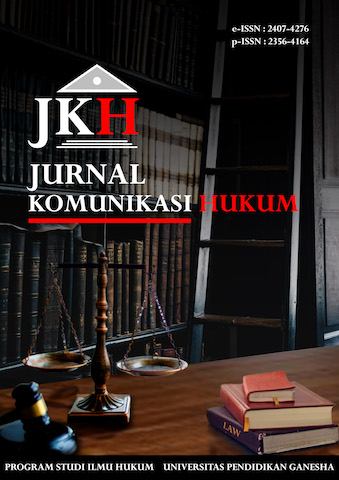LEGAL PROTECTION FOR LOCAL PRODUCTS THE SPIRIT OF SOBEAN AS A CITY BRANDING IN THE CONTEXT OF TOURISM MARKETING
DOI:
https://doi.org/10.23887/jkh.v9i1.55344Abstract
This study aims to determine, among others: (1) the formulation of indigenous village participation policies in the development of City Branding The Spirit of Sobean as a tourism marketing strategy in Buleleng Regency; (2) implementation of the policy formulation of traditional village participation in the development of City Branding The Spirit of Sobean as a tourism marketing strategy in Buleleng Regency; and (3) the implications of implementing the policy formulation of traditional village participation in the development of City Branding The Spirit of Sobean as a tourism marketing strategy in Buleleng Regency. This research is a normative juridical research with a statutory approach and a conceptual approach, the determination of the location and the research sample is determined purposively. Data collection techniques by means of observation, interviews and document studies. The research data analysis technique used descriptive qualitative analysis techniques. The results showed that the potential of the Buleleng area with the branding of The Spirit of Sobean. The development of the city branding of The Spirit of Sobean, Buleleng Regency with all existing components or sub-systems from local governments, entrepreneurs, and the arts and culture community can carry out the highest level of engaging tourism. The implication of the application of legal protection in the development of city branding The Spirit of Sobean is very large as a driver of sustainable tourism.
Downloads
Published
How to Cite
Issue
Section
License
Authors who publish with this journal agree to the following terms:- Authors retain copyright and grant the journal right of first publication with the work simultaneously licensed under a Creative Commons Attribution License that allows others to share the work with an acknowledgement of the work's authorship and initial publication in this journal.
- Authors are able to enter into separate, additional contractual arrangements for the non-exclusive distribution of the journal's published version of the work (e.g., post it to an institutional repository or publish it in a book), with an acknowledgement of its initial publication in this journal.
- Authors are permitted and encouraged to post their work online (e.g., in institutional repositories or on their website) prior to and during the submission process, as it can lead to productive exchanges, as well as earlier and greater citation of published work (See The Effect of Open Access).
Authors who publish with this journal agree to the following terms:
- Authors retain copyright and grant the journal right of first publication, with the work [SPECIFY PERIOD OF TIME] after publication simultaneously licensed under aCreative Commons Attribution License that allows others to share the work with an acknowledgement of the work's authorship and initial publication in this journal.
- Authors are able to enter into separate, additional contractual arrangements for the non-exclusive distribution of the journal's published version of the work (e.g., post it to an institutional repository or publish it in a book), with an acknowledgement of its initial publication in this journal.
- Authors are permitted and encouraged to post their work online (e.g., in institutional repositories or on their website) prior to and during the submission process, as it can lead to productive exchanges, as well as earlier and greater citation of published work (See The Effect of Open Access).












